Filenotes On Webstock 2013: News, Design & Dystopia

Filenotes on Webstock 2013 : News, Design & Dystopia
By Stephen
Olsen - Scooped
Images by Alastair Thompson - Scoop
Editor
Those attending the two days of Webstock held in Wellington on 14-15 February will have left with their heads spun outside-in and inside-out by 2013’s line up of digital and analog navigators.
The range of 23 standout Webstock speakers put forth potent points of view on (click author names to view their webstock abstracts):
- media content and journalism ( Clay Johnson, Miranda Mulligan, Karen McGrane);
- expositions about entrepreneurial highs and lows ( Jim Coudal , Jason Kottke );
- elegiac riffs devoted to the culture of publishing and public culture ( Craig Mod , Bruce Sterling, Robin Sloan ); and
- a collective masterclass in design-thinking ( Aza Raskin, Chris Coyier , Kelli Anderson , Mike Monteiro).
In addition to new takes on our cityscapes and the societies we live in ( Tricia Wang , Adam Greenfield , Eric Rodenbeck ), there were complementary salads for every kind of inventive mind or need, from the tech-face ( Artur Bergman , Jeremy Ashkenas, John Gruber ) to the myriad ways we work and interact with people ( Kitt Hodsden, Garr Reynolds , Michael Lopp ), rounded out by Jason Scott’s rage against dying seas of data and crowd favourite Tom Coates’ avowed obsession with physical objects as avatars of online services.
To borrow from author Robin Sloan - as Webstock’s Natasha Lampard did in her spot-on closing on Friday evening - entering the world of Webstock for the first time felt like entering "an open city, with all sorts of ways to wander in".

Click for big version
Webstock creator Natasha Lampard received a standing ovation at the end of this year's event
Given the size of the gathering it had elements of a love-in; dually enhanced by the coincidence of Valentines Day and an on-site wedding (headlined as "Tweethearts tie knot" in the DomPost & pictured here ). With the geographical connections being made with San Francisco it also felt like a tourist’s odyssey without having to expend any carbon miles across the Pacific rim. Here below are some paraphrased "chunks" from the event, signposted by quotable headers ( with photos from Scoop Editor and Webstock veteran Alastair Thompson ).
Contents:
1. "Confirmation bias is the new H1N1" - Clay Johnson
2. "Journalism needs to be a more thoughtful dresser" - Miranda Mulligan
3. "Truncation is not a content strategy" - Karen McGrane
4. "Be your own client" - Jim Coudal
5. Stellar.io "I built this - Jason Kottke
6. "Freight trains of unstoppable momentum" - Craig Mod
7. "Dark euphoria" - Bruce Sterling
8. A parable: "We are in the Black Mariah" - Robin Sloan
9. Designing within constraints - Aza Raskin
10. "I dispatch experiences out into the world" - Kelli Anderson
11. "Who can pull the plug on something that sucks?" - Mike Monteiro
[For more detail on the Webstock 2013 presentations: Follow the @webstock twitter account and webstock website for news of the posting of video of the presentations for Webstock 2013 & see the fantastic "Shared note taking" resource posted by Mike Riversdale >> HERE << .
You can also view photo sets from Webstock 2013 from Scoop's Alastair Thompson : Day One , Day two & via the official Webstock Flickr photo stream.]
"Confirmation bias is the new H1N1" - Clay Johnson.
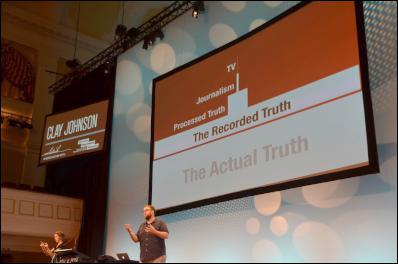
Clay Johnson - Click for big version
If, from the daily swill of media you unconsciously or consciously consume, you can name one or more Kardashian, how about the percentage of children in New Zealand caught under the term ‘child poverty’? (The answer is approximately one in five, but fewer than one in 100 at webstock seemed to know that).
From opening with this question Clay Johnson - a mobiliser of truth - moved on to the flat-out similarity between the fattening effects of junk food and the force-fed diet of industrialised media content, funded by artificial sweeteners, that leaves people believing "opinion tastes better than news". His point: "The definition of ignorance has changed. It’s now caused just as much by the consumption of information, as the lack thereof".
Nevertheless Clay wasn’t without hope that a whole new news movement could be enabled by people committed to conscious consumption of information and news.To sup orting media ahead of advertising. To moving up the literacy ladder to occupy a history-determining rung that celebrates the strength of networks, and the particular strength of networks which circulate truth and intelligence in a way that would be enabling of a renewed era of hyper-literacy. Not ceding the future to the face of Facebook.
"Journalism needs to be a more thoughtful dresser" - Miranda Mulligan
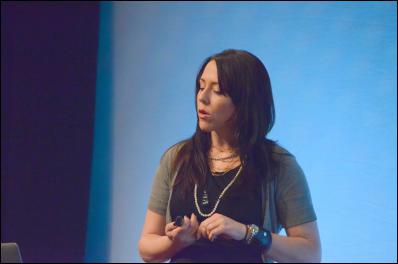
Miranda Mulligan - Click for big version
Listening to Miranda Mulligan - the designer behind the new responsive design (hint: try looking at it on a mobile phone and tablet device) BostonGlobe.com in 2011 - Webstockers learnt that her "clothing of a publication" by good design has a matriarchal lineage back into the clothing industry, albeit the fabrics she works with herself are digital.
Miranda proved to be an out-and-out champion for the leadership that designers can provide within news organisations - harnessing the abilities of people who work as master-researchers, communicators, problem solvers, anthropologists... Dependent though on people ceasing to be walled off from each other in silos, and more open-mindedness about skillsets.
"Truncation is not a content strategy" - Karen McGrane.

Karen McGrane - Click for big version
In her work providing guidance to media organisations (such as Conde Nast) about their online publishing Karen McGrane has a wealth of wisdom about how to bring together the orbiting planets of print, online, mobile. For her the way publishers are achieving outcomes is sub-optimal, however she hopes that the mobile revolution will provide the catalyst needed for the change yet needed.
And lots of yets remain. Firstly placing PDFs on tablets is not the answer. It isn’t contributing to uptake of online reading and it’s a wasteful use of designer time. Being hung up on the confines of a print page sees content remaining hard wired to form.
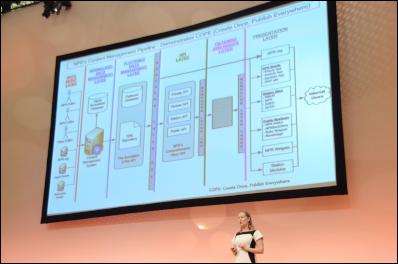
Click for big version
NPR's COPE (create once publish everywhere) content system schematic
Creating once, publishing everywhere (aka COPE - as implemented by NPR) isn’t yet the standard but should be. More useable content management systems - the backend publishing tools we call CMS's - foster better content, yet news productionCMS's seem to be the enterprise software that UX/ user experience designers forgot… "it's as if a database got drunk and vomited all over the interface".
Lastly the built in hierarchy and wisdom of editorial layouts - top story first etc. - still holds, yet isn’t consistently informing a decisive direction for many online publishers. The road to adaptive content could be even more open if fixed and lazy decisions predicated on making a web page go ‘live’ weren't holding back the deployment of that content.
"Be your own client" - Jim Coudal
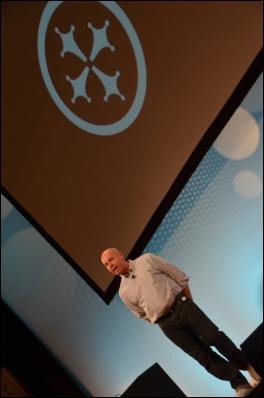
Jim Coudal - Click for big version
A recipe for a business model: Assuming there are people out there like us, and being open to serendipity.
On his quest to achieve a business with fun projects but sans pain in the ass clients these were some of the ingredients used by Jim Coudal. The concept of throwing caution to the wind, of bucking the "work for hire system" and of resisting the least resistable path of leaving the "ship in the dock" set an upbeat note for entrepreneurs at Webstock.
After all, as Jim put it, acting in favour of trusting your own instinct and judgment to back your own ideas is a very human "super power".
Recently Jim's digital marketing agency sacked its final client and now it works only on its own projects.
Stellar.io << I built this - Jason Kottke
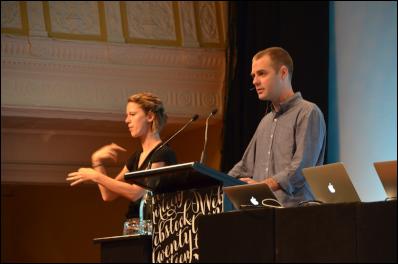
Jason Kottke - Click for big version
Then again, as noted by Coudal not everything works out well from the get go. Jason Kottke brought that lesson home with his tale of building a web app that has - a time of writing and for the time being - ended in a "web app writer’s block".
His tale tracked back over the history of a pioneer blogger enthused by the proto-ideas and slow hunches of which stellar.io consumed him. This was an app he’d been waiting and setting himself up for, capable of collecting social media favorites all in one place, an album of top hits where you’re the DJ, making "your own uncool" (a quote from artist Sol LeWitt).
The jury may be out on Jason Kottke’s cliffhanger of an app due to the shifting sands of media company APIs (access to source "favourite" data from the likes of Twitter), but never on Kottke’s simple philosophy to keep on going.
"Freight trains of unstoppable momentum" - Craig Mod

Craig Mod - Click for big version
Craig Mod came to praise the contemporary re-birthing of the next chapter of the book and magazine as brimming containers of content. Small issue sizes, small files sizes, reasonable subscriptions and a fluid publishing schedule: all praiseworthy.
In sum, the principles of subcompact publishing he surveyed - simplicity, speed and lightness, respect for producers and consumers alike and context - were all about one thing: delivering a scrollable experience up to "competing with Twitter (on your hand held device) in the wait time of queuing for a coffee". Think about that the next time you’re at Mojo.
"Dark euphoria" - Bruce Sterling

Bruce Sterling - Click for big version
Novelist Bruce Sterling’s rendition of the 20-teens as "dark euphoria" embedded itself in the general cultural sensibility at Webstock. In keeping with Wellington’s oft-popular dress code, Bruce was both black and more than a little bleak. Reading the last rites on Web 2.0 - "slowly dwindling away since 2008" - he railed against the dominance of the big 5 tech companies - "The Stacks" busily slapping tech features on to decaying institutions, with "spurious side-effects all the way down".
Now there is no frontier left, contended Bruce. "The railways have arrived and the barbed wire has gone up". This leaves internet users in the role of grazing livestock, monetized to within a kilobyte of every factual interaction, more and more inevitably encircled and entrapped. Taken to its logical extreme we are being reduced to stupid "beggary" by "upstart moguls", victims of a catatonic manipulation - transfixed by a giant warping distraction that behind the curtains is profoundly unstable but that poses automagically as some kind of grand spectacle. Dark euphoria indeed.
A parable: "We are in the Black Mariah" - Robin Sloan
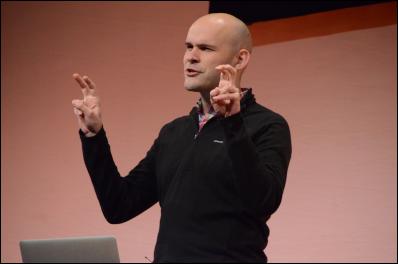
Robin Sloan - Click for big version
Where Bruce Sterling was all black, Robin Sloan leavened his Webstock talk by unraveling some time-travelling mystery.
First was his own invention in 2012 of a format to reflect the rhythm of speech, dubbed the "tap essay" and made into an app called Fish. Second was 1550, the era of books "coming online as an industry and intellectual network", and an ode to Aldus Manutius the inventor of italics.
Last but not least was 1900, or more specifically the years 1893 to 1903 when the likes of Thomas Edison and William Kennedy Dixon were virtually locked into the mystery of producing and projecting kinetoscope images in a reticulated, revolvable shed in New Jersey known as the "Black Mariah". Be it frames of boxing cats or Fred Ott’s eternal sneeze of seven seconds (patented), this was a shed that gave rise to "movies" before the word could even be quoted.
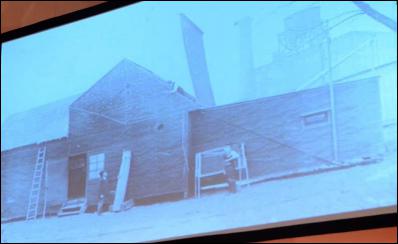
Click for big version
The Black Mariah - Thomas Edison's first moving image camera circa 1900
As put by Robin when we don’t quite have the "words" for what we "do", when we’re toggling back and forth between "technology" and "content" we only have to think and say that we’re working inside the "black box". Like the early movie camera which was yet to be given a name the smart touchable screen connected to the cloud (which is currently making billionaires) is still very much in its infancy.
Designing within constraints - Aza Raskin
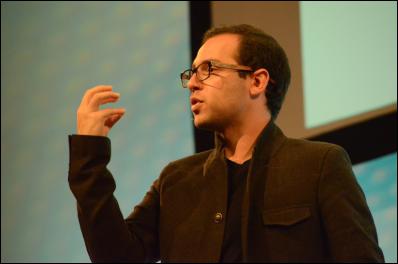
Click for big version
All seriousness aside if Aza Raskin wasn’t on the casting call for (sitcom) The Big Bang Theory it must have been a close call. At Webstock, Aza turned his serious attention to those things which present as constraints - poetic haiku, song forms, houses on footprints of 32 square metres - and their digital equivalents in the form of 140 character Tweets, Instagram, Snapchat (disposable photos)… all in their own way examples of the power of "parameterized design", as elegant and refined as a safety razor.
"I dispatch experiences out into the world" - Kelli Anderson
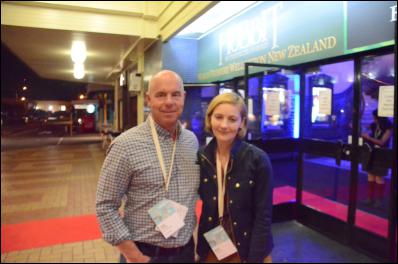
Click for big version
Kelli Anderson (with Jim Coudal at the after party)
After what amounted to a standing ovation, it would be fair to say no one left Kelli Anderson’s show-and-tell of designer finesse at Webstock without wanting to do what Kelli does to find the hidden talents of everyday things in unexpected ways and places. This was the art of the portfolio writ small and large; in the pursuit of the "infinite how-how-how" of design as the communication of modulating texture, colour, composition.
For Kelli the canvas is an "infrastructure of ever changing cultural definitions". Against the backdrop of a perpetual Groundhog Day the act of design is an act of "experimenting with our intuition and second guesses", choosing between order and creative mischief. To achieve that mischief Kelli recommended the necessity of messing with expectations and of refusing to "sleepwalk through our assumptions about media".
A pinnacle that combined both, was her participation in the team that turned out a perfect counterfeit of the New York Times on to the streets in 2008. It recreated the newspaper with news that was coined from the concept of what news might look like if popular pressure was genuinely applied in everyday life - leading to headlines proclaiming the end of the war in Iraq. Presenting a blueprint for a better alternative world. Kelli Anderson: "It had to be radically believable and it caught people off guard, it conflicted their beliefs… it demonstrated democracy should be something we invent together".
"Who can pull the plug on something that sucks?" - Mike Monteiro
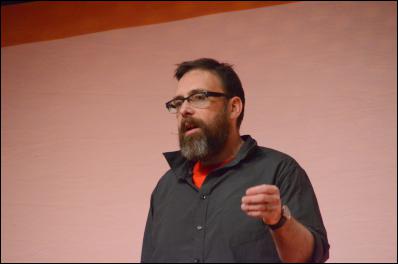
Mike Monteiro - Click for big version
Mike Monteiro provided a hard-ass exclamation mark at Webstock with an affirmative YOU as the answer to this question. Under the provocative title ‘How Designers Destroyed The World’, Mr Monteiro mounted an assault on those decisions which ignore consequences and that as a result see designers emerge as, "at best negligent, at worst culpable".
Here was a manifesto of responsibilities. To the world we live in (not the monsters we unleash). To the craft of design. To clients (remembering that "no one hired you to be their friend"). To self ("all our choices define us"). Having earlier invoked designer Victor Papanek as a personal hero, Mr Monteiro put five vices on the block for destruction: Fear, Apathy, Petty Authority, The Voice Inside, Misogyny. No chef worthy of the vocation serves up rancid food, and designers should be no different in the care they devote to their work. His wake-up call to action was a simple invocation: "We are capable of so much more".
ENDS


 Richard S. Ehrlich: The Dalai Lama's Escape & CIA Money
Richard S. Ehrlich: The Dalai Lama's Escape & CIA Money Binoy Kampmark: Addressing Hate Speech And Incitement - Holding Meta Accountable In Africa
Binoy Kampmark: Addressing Hate Speech And Incitement - Holding Meta Accountable In Africa Binoy Kampmark: Closed For Business - The Oddities Of Trump’s Tariffs
Binoy Kampmark: Closed For Business - The Oddities Of Trump’s Tariffs Martin LeFevre - Meditations: Teach Children The Distinction Between The World And Nature
Martin LeFevre - Meditations: Teach Children The Distinction Between The World And Nature Ramzy Baroud: Civil War On The Horizon? The Ashkenazi-Sephardic Conflict And Israel’s Future
Ramzy Baroud: Civil War On The Horizon? The Ashkenazi-Sephardic Conflict And Israel’s Future Gordon Campbell: On The Government’s Latest Ferries Scam
Gordon Campbell: On The Government’s Latest Ferries Scam